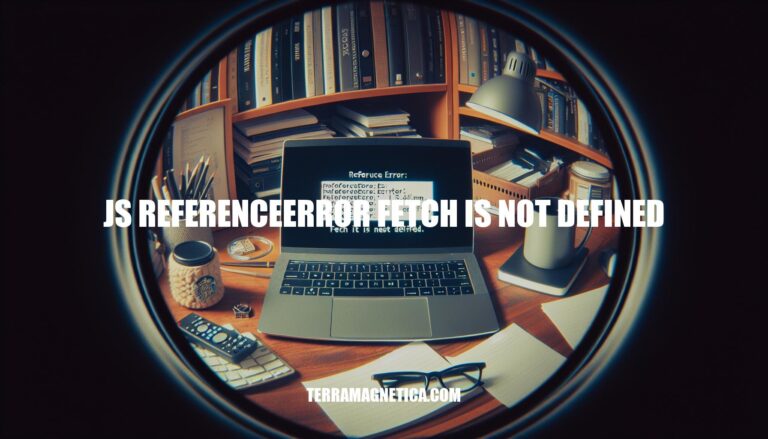


Are you struggling with the ‘js referenceerror fetch is not defined’ issue in your Node.js environment? This common error can be frustrating, but fear not – we have solutions to help you overcome it. Read on to learn practical steps to resolve this error and ensure smooth execution of your fetch API calls.
The “ReferenceError: fetch is not defined” occurs when the fetch() method is used in an environment where it’s not supported, most commonly in Node.js. To resolve this error, you can follow these steps:
Install and import the node-fetch package:
node-fetch library using the following command:
npm install node-fetch
const fetch = require('node-fetch');
Use fetch with the correct syntax:
fetch('https://example.com/')
.then(res => res.text())
.then(body => console.log(body));
fetch('https://sochain.com/api/v2/address/LTC/LMSuo8W7CiXs8oFs1sJh77AQ54tCZM42Ay')
.then(res => res.json())
.then(json => console.log(json));
Remember that fetch is a browser API, so in Node.js, you need to use third-party libraries like node-fetch
The ‘fetch is not defined’ error occurs in environments like Node.js where the Fetch API is not natively supported. To handle this error, you can use a polyfill or an alternative library that provides fetch functionality. Here are a couple of solutions:
node-fetch: A popular choice for Node.js environments. You can install it using npm:
npm install node-fetch
Then, import it at the top of your files where you need fetch:
import fetch from 'node-fetch';
If you’re using CommonJS, you can require it as follows:
const fetch = require('node-fetch');
isomorphic-fetch: This module enables fetch both on the server and client side. Install it with:
npm install --save isomorphic-fetch es6-promise
And then import it in your project:
import 'isomorphic-fetch';
Remember to check the documentation of these libraries for more details and best practices for implementation.
Polyfills play a crucial role in JavaScript development, especially when it comes to ensuring that web applications work consistently across different browsers and versions. Here’s why they are important:
Implementing polyfills in JavaScript is generally straightforward. For example, if a new JavaScript function isn’t supported in certain browsers, a polyfill can provide an equivalent implementation, allowing it to work across different environments.
For more detailed insights, you might want to read articles that delve into the full overview of JavaScript polyfills and their implementation.
Here’s a basic polyfill for the Fetch API in JavaScript. This polyfill checks if the fetch function is already implemented in the browser. If not, it provides a simple implementation using XMLHttpRequest.
This is a simplified version and might not cover all use cases or features of the Fetch API, but it should give you a good starting point:
if (!window.fetch) {
window.fetch = function(url, options) {
return new Promise(function(resolve, reject) {
var xhr = new XMLHttpRequest();
xhr.open(options.method || 'get', url);
for (var key in options.headers) {
xhr.setRequestHeader(key, options.headers[key]);
}
xhr.onload = function() {
resolve(response(xhr));
};
xhr.onerror = reject;
xhr.send(options.body);
});
};
function response(xhr) {
var keys = [];
var all = [];
var headers = {};
var header;
xhr.getAllResponseHeaders().replace(/^(.*?):\\s*([\\s\\S]*?)$/gm, function(m, key, value) {
keys.push(key = key.toLowerCase());
all.push([key, value]);
header = headers[key];
headers[key] = header ? `${header},${value}` : value;
});
return {
ok: (xhr.status/100|0) == 2, // 200-299
status: xhr.status,
statusText: xhr.statusText,
url: xhr.responseURL,
clone: response,
text: function() { return Promise.resolve(xhr.responseText); },
json: function() { return Promise.resolve(xhr.responseText).then(JSON.parse); },
blob: function() { return Promise.resolve(new Blob([xhr.response])); },
headers: {
keys: function() { return keys; },
entries: function() { return all; },
get: function(n) { return headers[n.toLowerCase()]; },
has: function(n) { return n.toLowerCase() in headers; }
}
};
}
}
This polyfill will allow you to use fetch to make network requests in browsers that do not support it natively. For a more robust solution, you might want to consider using a library like whatwg-fetch, which is a more complete polyfill that supports a wider range of the Fetch API’s features. Remember to also include a Promise polyfill if you’re targeting browsers that don’t support Promises natively.
The error fetch is not defined typically occurs when you try to use the fetch API in a Node.js environment where it is not available by default. Here’s how you can resolve this issue:
fetch API is available natively. You don’t need to install anything extra.node-fetch. You can do this by running the following command in your terminal:npm install node-fetch
Then, at the top of your JavaScript file, you need to import fetch from node-fetch like so:
import fetch from 'node-fetch';
Or, if you’re using CommonJS syntax:
const fetch = require('node-fetch');
Make sure to include these import statements before you try to use fetch in your code. This should resolve the fetch is not defined error.
If you’re still encountering issues, please provide more details about your code and environment, and I’ll be happy to help further!
In conclusion, encountering the ‘js referenceerror fetch is not defined’ error can be a roadblock in your web development journey. By following the steps outlined in this article, such as installing external modules like ‘node-fetch’ or using polyfills, you can sidestep this error and continue harnessing the power of the fetch API in your Node.js projects. Remember, with the right tools and knowledge, you can overcome any coding challenge and enhance your development skills.
Let this error be a mere bump in the road on your path to becoming a proficient web developer.